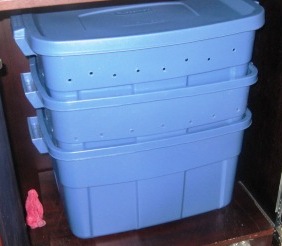Originally I didn’t want to publish this here because it uses larger 18-gallon bins, but under my new definition of bucket it’s allowed in.
I built my worm farm last winter and stocked it with red worms from our backyard compost bin. It was a successful project, and a great experience, so I’ll probably build another one in my new place soon.
I fed it a very rich food scraps diet for a month or two, then neglected it for four months. When I harvested it, the worms were still alive and happy and the compost they lived in was the richest, sweetest smelling compost I ever laid my nostrils on (and I’ve handled a lot of compost.)
The three-bin worm farm I built is much easier to maintain than a one-bin systems. You can see the full tutorial on DIYwormbin.com





